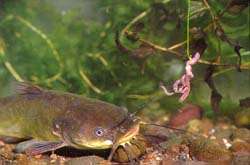Interactions with other species
Bullheads are a visually deficient fish, meaning they have weak eyesight. They rely on their acute sense of smell and taste to find prey. In an experiment conducted on Ameiurus natalis, even when blinded they still functioned in complicated social relationships and are able to sense other fish or organisms (Todd, 1967).
Yellow bullhead fish are prey for a variety of creatures. One species that preys on the bullhead is the Cottonmouth Moccasin. Evidence has been found proving these snakes ingest large members of the bullhead family, but these aren't the only predators it has to fear. Other snakes sometimes enjoy the fish as a meal as well. (Yerger, 1953).
Humans have a distant relationship with this particular fish. Although a small sport fishing industry exists, people generally seem to have little interest in eating it (Priegel, 1959) but according to the Wisconsin DNR, it is a fun fish to catch and tasty to eat if you know how to prepare it. Unfortunately, the fish can be a nuisance to fisheries managers.
While searching for food the yellow bullhead can have a negative impact on other fish in its habitat. They are known for muddying water, making it difficult for bass, bluegills, and waterfowl to find cover. Bullheads have also been known to eat other sport-fishes young and are able to quickly overpopulate competing species with their high reproductive rates. Fortunately for people interested in fishing for this particular species, there are no fishing limits in place (DNR).
Go to our reference page to see
where we acquired our information on the yellow bullhead
or
Return to Home

